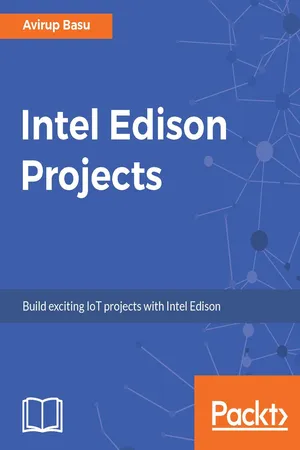
Intel Edison Projects
Avirup Basu
- 264 Seiten
- English
- ePUB (handyfreundlich)
- Über iOS und Android verfügbar
Intel Edison Projects
Avirup Basu
Über dieses Buch
Build powerful Robots and IoT solutions using Intel EdisonAbout This Book• Learn to build advanced level robots with Intel Edison and Arduino• Efficiently build and program home automation and IoT projects with Intel Edison• Master the skills of creating enticing projects with Intel Edison.Who This Book Is ForIf you are a hobbyist, robot engineer, IoT enthusiast, programmer, or developer who wants to create autonomous projects with Intel Edison, then this book is for you. Prior programming knowledge would be beneficial.What You Will Learn• Program your device using the Arduino processor language, Python, and Node.js• Interface different sensors with the Intel Edison• Build a home automation system using MQTT, Android, and WPF• Perform face detection using Intel Edison• Develop a high-speed line follower robot• Control a robot using a PC application and an custom controllerIn DetailChange the way you look at embedded electronics with Intel Edison. It is a small computing platform packed with a set of robust features to deliver hands-on performance, durability, and software support.This book is a perfect place to kickstart development and rapid prototyping using Intel Edison. It will start by introducing readers to the Intel Edison board and explaining how to get started with it. You will learn how to build a mini weather station, which will help you to acquire temperature and smoke level and push it to the IoT platform. Then you will see how to build a home automation device and control your appliances using an Android app. Furthermore, we will build a security system using a webcam to detect faces and perform voice recognition. Toward the end, the book will demonstrate how you can build two robots, which will be based on different line sensing sensors and can be controlled by a PC.The book will guide the readers through each and every step of execution of a project, using Intel Edison.Style and approachA project-based guide that will take the readers through various domains of projects like robotics, IoT and so on.
Häufig gestellte Fragen
Information
Intel Edison and IoT (Home Automation)
- The various concepts of controlling devices using the Internet MQTT protocol
- Using Edison to push data and get data using the MQTT protocol
- LED control using the MQTT protocol
- Home automation use cases using the MQTT protocol
- The controller application in Android (MyMqtt) and in WPF (to be developed)
Controlling devices using the Internet - concepts
REST services
Instructions or alerts (present on most IoT platforms)
Architecture
